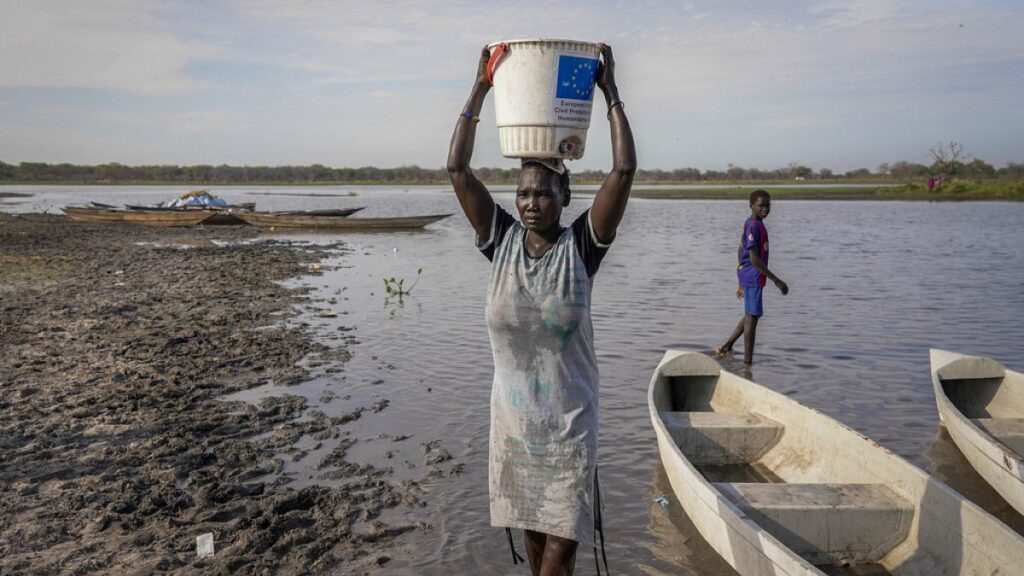The ongoing burden of rising global crises has exacerbated hunger in Africa, Asia and the Middle East, UN agencies warn.
According to the UN’s State of Food Security and Nutrition in the World 2025 report, also known as the SOFI report, trade tensions, conflicts and climate change are the primary causes of global food inflation.
The report, which gathers data from five international organisations — FAO, IFAD, UNICEF, WFP, and WHO — was drafted by IFAD, a Rome-based UN agency that provides grants and low-interest loans to fund projects in developing countries.
“The situation is quite alarming, especially in Africa and in the Middle East,” Álvaro Lario, president of IFAD, told Euronews.
“It’s a mixture between the conflicts, some of the disruption or shocks caused by economic or trade tensions and also the climate shocks. These are the three main drivers,” Lario explained.
Since the trade tensions of 2018, during the first Trump administration, elevated tariffs have mainly remained in place, contributing to ongoing trade tensions and influencing global agricultural trade dynamics.
The figures of the survey show that the proportion of the population facing hunger in Africa surpassed 20% in 2024, affecting 307 million people, while in the Middle East an estimated 12.7% of the population, or more than 39 million people, faced hunger in 2024.
Small farming activities under threat
Increasingly dire living conditions for small farmers and rural populations in developing countries are catalysts for economic migration flows.
“It’s clear, when people do not have the ability of really having a livelihood where they are, then they are forced to migrate,” Lario said.
The link between migration, the ability to feed oneself, and the ability to also continue producing food is clear, he added.
According to UN criteria, small-scale farmers are those who exploit less than 2 hectares of land. They produce one-third of the world’s food and up to 70% of the food in Africa.
The economic existence and sustainability of small-scale farmers are quintessential to food supply and food security in developing countries.
Yet, according to international standards, they all live under the poverty threshold. They represent 80% of the world’s poorest population.
According to the IFAD assessment, international aid to agriculture doesn’t meet the needs of small-scale farmers: in fact, they receive less than 1% of climate finance, which amounts to slightly more than €4 billion per year, when they would need more than €70 billion.
Long-term investment in agriculture and small-scale farmers in developing countries is crucial for addressing global hunger.
“Africa imports approximately €70, 80 billion of food every year. Clearly, they could be self-sufficient and they could create a lot of those jobs in Africa,” said Lario.
Each year, approximately 10 million young Africans enter the job market.
“There could be many jobs created in terms of not only production, but distribution, storage, marketing, exporting,” Lario stated.
Rising conflicts disrupt the food chain
According to the Integrated Food Security Phase Classification (IPC), more than 35 million people are living in a state of emergency (IPC Phase 4), and almost 2 million have reached IPC Phase 5, which is categorised as “catastrophe”.
Places where the population is facing extreme degrees of food insecurity are the Palestinians living in the Gaza Strip, along with South Sudan, Sudan, Yemen and Haiti.
The survey indicates that 100% of the population in the Gaza Strip faces high levels of acute food insecurity, affecting a total of 1,106,900 people, nearly twice the 576,000 recorded in 2023, the highest numbers ever estimated globally in IPC history.
“The situation is quite alarming, especially in Africa and especially in the Middle East. I would say those are the two areas where we’re saying the numbers continue to increase,” concluded Lario.
Read the full article here


